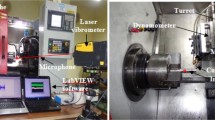Abstract
This research shows the development of an in-process surface roughness adaptive control (ISRAC) system in turning operations. An artificial neural network (ANN) was employed to establish two subsystems: the neural network-based, in-process surface roughness prediction (INNSRP) subsystem and the neural network-based, in-process adaptive parameter control (INNAPC) subsystem. The two subsystems predicted surface roughness and adapted feed rate using data from not only cutting parameters (such as feed rate, spindle speed, and depth of cut), but also vibration signals detected by an accelerometer sensor. The INNSRP subsystem predicted surface roughness during the finish cutting process with an accuracy of 92.42%. The integration of the two subsystems led to the neural-networks-based surface roughness adaptive control (INNSRAC) system. The 100% success rate for adaptive control of the test runs proved that this proposed system could be implemented to adaptively control surface roughness during turning operations.
Similar content being viewed by others
References
Abouelatta O.B., Madl J. (2001). Surface roughness prediction based on cutting parameters and tool vibrations in turning operations. Journal of Materials Processing Technology 118(1–3): 269–277
Al-kindi G.A., Baul R.M., Gill K.F. (1992). Application of machine vision in the automated inspection of engineering surfaces. International of Production Research 30(2): 241–253
Beauchamp Y., Thomas M. Youssef Y.A., Masounave J. (1996). Investigation of cutting parameter effects on surface roughness in lathe boring operation by use of a full factorial design. Computer and Industrial Engineering, 31(3–4): 645–651
DeGarmo E.P, Black J.T., Kohser R.A. (1997). Materials and processes in manufacturing, 8th ed. Upper saddle river NJ, Prentice Hall
Elanayar S., Shin Y.C. (1995). Robust tool wear estimation with radial basis function neural network. Journal of Dynamic System, Measurement and Control 117: 459–467
Fang X.D., Yao Y.L. (1997). In-process evaluation of the overall machining performance in finish-turning via single data source. Transactions of ASME 119: 444–447
Freeman J.A., Skapura D.M. (1991). Neural networks: algorithms, applications, and programming techniques. Addison-Wesley, MA, Reading
Harig, H. (1978). Basic precision machining for metalworking trainees. Washington, DC: National Tool, Die, & Precision Machining Association.
Ho S.-Y., Lee K.-C., Chen S.-S., Ho S.-J. (2002). Accurate modeling and prediction of surface roughness by computer vision in turning operations using an adaptive neuro-fuzzy inference system. International Journal of Machine Tools and Manufacture 42(13): 1441–1446
Hoy D.E.P., Yu F. (1991). Surface quality assessment using computer vision methods. Journal of Materials Processing Technology 28(1–2): 265–274
Huang, P. B. (2002). A neural network-based in-process adaptive surface roughness control (NN-IASRC) system in end-milling operations. Ph.D. dissertation, Iowa State University, Ames, IA.
Huang B., Chen J.C. (2001). An in-process neural network-based surface roughness prediction (INN-SRP) system using a dynamometer in end milling operations. International Journal of Advanced Manufacturing Technology 21(5): 339–347
Huang, L., & Chen, J. C. (2001). A multiple regression model to predict in-process surface roughness in turning operations via accelerometer. Journal of Industrial Technology, 17(2). Retrieved March 4, 2004 from http://www.nait.org/
Jang Y.D., Choi Y.G., Kim H.G., Hsiao A. (1996). Study of the correlation between surface roughness and cutting vibrations to develop an on-line roughness measuring technique in hard turning. International Journal of Machine Tools Manufacturing 36(4): 453–464
Kiran M.B, Ramamoorthy B., Radhakrishnan V. (1998) Evaluation of surface roughness by vision system International Journal of Machine Tools & Manufacture 38(5–6): 685–690
Kopac J., Bahor M., Sokovic M. (2002). Optimal machining parameters for achieving the desired surface roughness in fine turning of cold pre-formed steel workpieces. International Journal of Machine Tools and Manufacture 42: 707–716
Lee S.S., Chen J.C. (2003). On-line surface roughness recognition system using artificial neural networks system in turning operations. International Journal of Advanced Manufacturing Technology 22: 498–509
Lee B.Y., Tarng Y.S. (2001). Surface roughness inspection by computer vision in turning operations. International Journal of Machine Tools and Manufacture 41(9): 1251–1263
Lin S.C., Chang M.F. (1998). Study on the effects of vibrations on the surface finish using a surface topography simulation model for turning. International Journal of Machine Tools & Manufacture 38(7): 763–782
Lippmann, R. (1999). An introduction to computing with neural nets. In Mahra, P., & Wah, B. W. (Eds.), Artificial neural networks: Concepts and theory (pp. 13–31). Los Alamitos, CA: IEEE Computer Society Press
Mainsah E., Ndumu D.T. (1998). Neural network applications in surface topography. International Journal of Machine Tools Manufacturing, 38(5–6): 591–598
McClelland A., Rumelhart P. (1988). Explorations in parallel distributed processing. Cambridge MA, MIT Press
Oberg E., Jones F.D., Horton H.L., Ryffel H.H. (1996). Machinery’s handbook. New York, NY, Industrial Press Inc
Risbood K.A., Dixit U.S., Sahasrabudhe A.D. (2003). Prediction of surface roughness and dimensional deviation by measuring cutting forces and vibrations in turning process. Journal of Materials Processing Technology 132(1–3): 203–214
VNE Corporation (1999). Versa-turn catalog. Janesville, WI: Author.
Yan D., Cheng M., Popplewell N., Balakrishnan S. (1995). Application of neural networks for surface roughness measurement in finish turning. International Journal of Production Research 33(12): 3425–3438
Yang W.H., Tarng Y.S. (1998). Design optimization of cutting parameters for turning operations based on the taguchi method. Journal of Materials Processing Technology 84(1–3): 122–129
Zuperl U., Cus F. (2003). Optimization of cutting conditions during cutting by using neural networks. Robotics and Computer Integrated Manufacturing 19(1–2): 189–199
Author information
Authors and Affiliations
Corresponding author
Rights and permissions
About this article
Cite this article
Zhang, J.Z., Chen, J.C. & Kirby, E.D. The development of an in-process surface roughness adaptive control system in turning operations. J Intell Manuf 18, 301–311 (2007). https://doi.org/10.1007/s10845-007-0024-x
Received:
Accepted:
Published:
Issue Date:
DOI: https://doi.org/10.1007/s10845-007-0024-x




